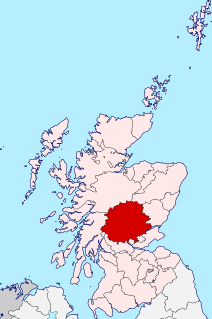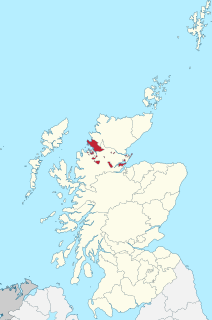Related Research Articles

Perthshire, officially the County of Perth, is a historic county and registration county in central Scotland. Geographically it extends from Strathmore in the east, to the Pass of Drumochter in the north, Rannoch Moor and Ben Lui in the west, and Aberfoyle in the south; it borders the counties of Inverness-shire and Aberdeenshire to the north, Angus to the east, Fife, Kinross-shire, Clackmannanshire, Stirlingshire and Dunbartonshire to the south and Argyllshire to the west. It was a local government county from 1890 to 1930.

Cromartyshire is a historic county in the Highlands of Scotland, comprising the medieval "old shire" around the county town of Cromarty and 22 enclaves and exclaves transferred from Ross-shire in the late 17th century. The largest part, six times the size of the old shire, is Coigach, northwest from Ullapool. In 1890, Cromartyshire was merged with Ross-shire into the administrative county of Ross and Cromarty. In 1975, the resulting county was combined with Caithness, Inverness-shire, Nairnshire, Sutherland, and parts of Argyllshire and Morayshire to form the Highland council area.

A royal burgh was a type of Scottish burgh which had been founded by, or subsequently granted, a royal charter. Although abolished by law in 1975, the term is still used by many former royal burghs.

The shires of Scotland, or counties of Scotland, are historic subdivisions of Scotland established in the Middle Ages and used as administrative divisions until 1975. Originally established for judicial purposes, from the 17th century they started to be used for local administration purposes as well. The areas used for judicial functions (sheriffdoms) came to diverge from the shires, which ceased to be used for local government purposes after 1975 under the Local Government (Scotland) Act 1973.

Earl of Rosslyn is a title in the Peerage of the United Kingdom. It was created in 1801 for Alexander Wedderburn, 1st Baron Loughborough, Lord Chancellor from 1793 to 1801, with special remainder to his nephew Sir James St Clair-Erskine, as Wedderburn had no surviving issue of his own. Wedderburn had already been created Baron Loughborough, of Loughborough in the County of Leicester, in the Peerage of Great Britain in 1780, with normal remainder to the heirs male of his body, and Baron Loughborough, of Loughborough in the County of Surrey, in the Peerage of Great Britain in 1795, with the same remainder as the earldom. The 1780 barony became extinct upon his death, but the 1795 barony and the earldom passed, by the special remainder, to his nephew, who thus became the second Earl of Rosslyn. The second Earl was a Lieutenant-General in the Army and also held political office as Lord Privy Seal and Lord President of the Council.

Anstruther is a small coastal resort town in Fife, Scotland, situated on the north-shore of the Firth of Forth and 9 mi (14 km) south-southeast of St Andrews. The town comprises two settlements, Anstruther Easter and Anstruther Wester, which are divided by a stream, the Dreel Burn. With a population of 3,500, it is the largest community on the Firth of Forth's north-shore coastline known as the East Neuk. To the east, it merges with the village of Cellardyke.

Clan Anstruther is a Scottish clan.

In Scotland, a baron is the head of a feudal barony, also known as a prescriptive barony. This used to be attached to a particular piece of land on which was situated the caput or essence of the barony, normally a building, such as a castle or manor house. Accordingly, the owner of the piece of land containing the caput was called a baron. According to Grant, there were around 350 identifiable local baronies in Scotland by the early fifteenth century and these could mostly be mapped against local parish boundaries. The term baron was in general use from the thirteenth century to describe what would have been known in England as a knight of the shire.
Tain Burghs, was a constituency of the House of Commons of the Parliament of Great Britain from 1708 to 1801 and of the Parliament of the United Kingdom from 1801 to 1832, sometimes known as Northern Burghs. It was represented by one Member of Parliament (MP).

The Right Hon. William Adam of Blair Adam was a Scottish advocate, barrister, politician and judge. He served as Solicitor General for Scotland (1802–1805) and as Lord Chief Commissioner of the Jury Court (1815–39).
Charles Hope, 1st Earl of Hopetoun KT was a Scottish nobleman.

Sir John Anstruther, 1st Baronet was a Scottish politician who sat in the Parliament of Scotland from 1702 to 1707, and in the British House of Commons from 1708 to 1741.
Sir George Lauder of the Bass, Knight, was a cleric, Privy Counsellor, and Member of the Scottish Parliament. He was also Tutor to Henry Frederick, Prince of Wales.
Sir Alexander Lauder of Blyth, Knt. was Provost of Edinburgh almost continually from 1500 to 1513. He was Commissioner to the Scottish Parliament, 1504–06, and an Auditor of the Exchequer in Scotland. He appears to have been on terms of intimacy with the King, James IV, with whom he played cards and to whom he occasionally lent money. "He led the men of Edinburgh to join the King's host" at the battle of Flodden, and fell there.
Sir Robert Anstruther, 1st Baronet, of Wrae, Linlithgow, and Balcaskie, Fife, was a Scottish politician who sat in the Parliament of Scotland between 1681 and 1707 and in the British House of Commons from 1709 to 1710.
Sir William Anstruther, Lord Anstruther was a Scottish judge.
Nairnshire was a constituency of the Parliament of Scotland before the Union with England in 1707. The barons of the shire or sheriffdom of Nairn elected two commissioners to represent them in the Parliament and in the Convention of Estates.
Mungo Graham or Graeme (1670–1754), of Gorthy, Perthshire, was a Scottish politician who sat in the Parliament of Scotland from 1702 to 1707 and in the British House of Commons between 1707 and 1711. He was Rector of the University of Glasgow from 1718 to 1720.
The Barony of Muirton is a Scottish feudal barony near Forres along the Findhorn River in Moray.
Sir James Anstruther of Anstruther, was a Scottish landowner and courtier.
References
- ↑ Sibbald, R. (1803). The History, Ancient and Modern, of the Sheriffdoms of Fife and Kinross: With the Description of Both, and of the Firths of Forth and Tay, and the Islands in Them ... with an Account of the Natural Products of the Land and Waters. R. Tullis. p. 343. Retrieved 30 April 2019.
... time, to the same Sir Robert Anstruther, to be their ambassadour and plenipotentiary, for settling all differences betwixt the Roman ... hath a charter, from Queen Ann (which I have read) dated at Kensingtoun, the 29th of April 1704, of the baronies of Anstruther ... And the same charter constitutes him heritably, one of the Cibi cidæ or Carvers, and one of the Master-housholds to her majesty and her ...
- ↑ Young, M.D.; Scotland. Parliament (1992). The Parliaments of Scotland: Burgh and Shire Commissioners. The Parliaments of Scotland: Burgh and Shire Commissioners. Scottish Committee on the History of Parliament. p. 21. ISBN 978-0-7073-0703-9 . Retrieved 30 April 2019.